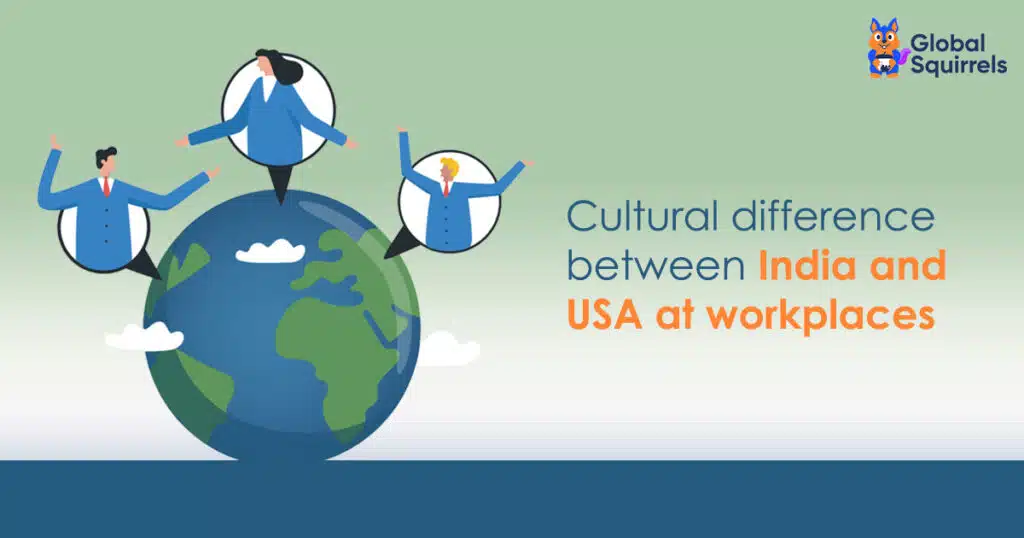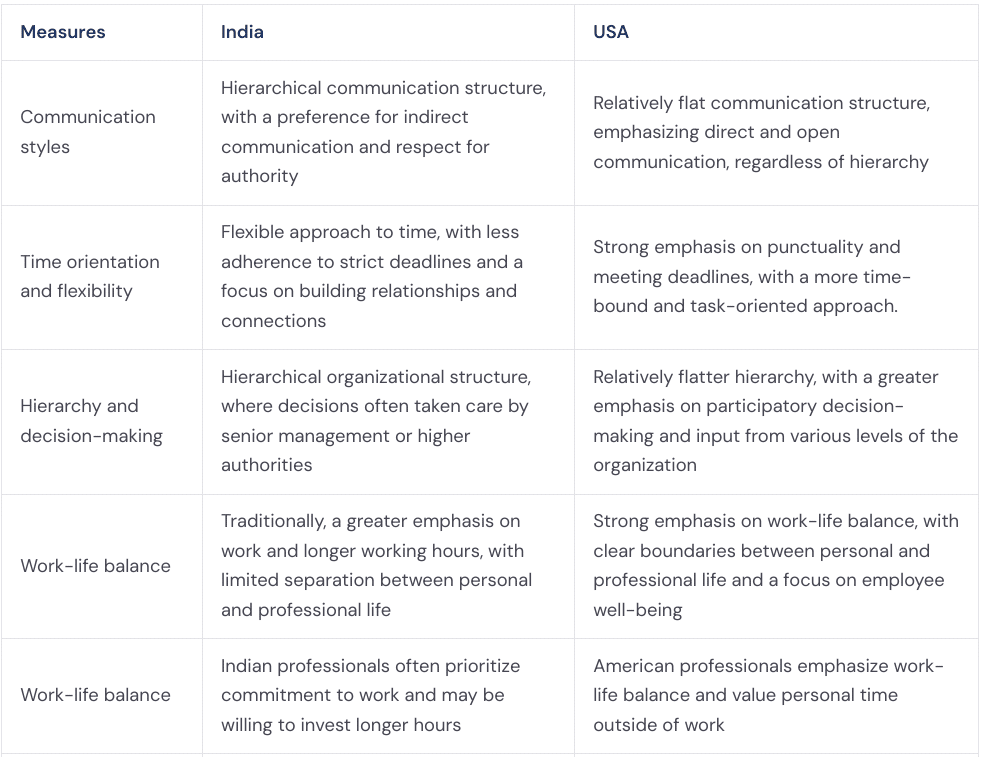Cultural Difference Between India and USA at Workplaces

As globalization continues to shape the modern business landscape, organizations are increasingly operating in diverse cultural contexts. Understanding and navigating Indian culture in the workplace, along with other cultural nuances, is crucial for fostering effective collaboration and creating harmonious work environments.This blog explores the work culture difference between India and USA by examining key aspects such as communication styles, hierarchical structures, work-life balance, and approaches to teamwork.Whether you are an expatriate, a global manager, a business owner, or simply curious about cultural dynamics, this article will provide you with a deeper understanding of the work culture in US vs India.
What is the work culture difference between India and USA?
1. Communication styles
Direct vs indirect communication is the extensive work culture difference between India and USA. When it comes to the American work culture vs Indian work culture, you will see that in America, people are usually frank and direct about their thoughts, disagreements, and what they want. Indian work culture, on the other hand, can lean more heavily on a more indirect approach to keeping the peace and not making other people ‘lose face.’ Misunderstandings may arise from this cultural distinction: Americans might regard Indian colleagues as evasive, e.g., or unclear, while Indian colleagues of Americans may judge Americans as too blunt or even rude.To bridge such communication gaps, many global businesses hire interpreters and translators for better collaboration
2. Hierarchical structure
In the American work culture vs Indian work culture, respect towards authority is also a distinction in such structures.
India: Indian workplaces pride themselves in their respect for the hierarchy, and thus, most decisions are made further up the hierarchy, and employees may hesitate to disagree or challenge their superiors.
USA: work culture is one that entices all levels of employees to constantly put their heads up and come up with new ideas and give feedback. That difference can spike, especially if Indian employees don’t feel comfortable speaking up in meetings where there are plenty of American colleagues.
3. Work ethic
The USA has a strong emphasis on the work culture that revolves around ‘Work Ethic’ and ‘Time Management,’ with punctuality and huge deadlines. Indian work culture (although at times frustrating for American colleagues who are used to tight deadlines) is generally more flexible with time management than in America, however. These different ways people approach time mirror the larger cultural gap in the Indian work culture vs American work culture.
Similar topic: Cultural differences between Mexico and USA
Work culture in India
In India, a diverse nation with a rich heritage, the work culture reflects a unique blend of traditions, values, and modern influences. Understanding the work culture in India is crucial for professionals and organizations utilizing Indian talent in their workplaces. Let’s walk through the main aspects of work culture in India, providing insights and guidance for navigating this dynamic landscape. Learn more about work culture in India for a better understanding of how people in India work.
1. Hierarchy and respect
In Indian work culture, hierarchy holds significant importance. There is a strong emphasis on respecting authority and adhering to established hierarchies within organizations. Seniority and age often determine decision-making power, and it is customary to show deference to superiors. Addressing colleagues and managers with appropriate titles and using formal language is considered respectful.
2. Strong sense of community
Work culture in India places a high value on relationships and fostering a sense of community. Colleagues often develop strong bonds and may extend their interactions beyond the workplace. Building personal connections and maintaining harmonious relationships are integral to the work environment. Teamwork and collaboration are emphasized, with collective achievements celebrated.
3. Long working hours
India has a reputation for long working hours. Many professionals work beyond the standard 40-hour workweek, driven by the commitment to meet deadlines and achieve targets. However, this trend is slowly evolving, with a growing focus on work-life balance and employee well-being in specific sectors.
4. Flexibility and adaptability
Indian work culture is known for its flexibility and adaptability. Professionals often need to navigate rapidly changing situations and adjust their work priorities accordingly. The ability to adapt to new circumstances and demonstrate flexibility is highly regarded.
5. Workforce diversity
India is a diverse country with a multitude of languages, religions, and cultural backgrounds. This diversity is also reflected in the workplace. Organizations in India promote inclusivity and strive to provide equal opportunities for employees from various backgrounds. Diversity of perspectives is seen as a strength that fosters innovation and creativity.
6. Importance of traditions in Indian work culture
India’s work culture is shaped by its famous for its colorful festivals and celebrations. Diwali, Holi, and Eid are celebrated at Indian workplaces, and there is a feeling of joy and community. They help to connect with colleagues and create a great environment in which to work. This aspect of Indian work culture stands in contrast to American workplaces, where such celebrations are typically less prominent. These practices are evidence of a work culture difference between India and USA, where the American work culture is much more individual-focused and more focused on individual accomplishments and professional milestones. The Indian work culture vs American emphasizes the role of cultural values in determining the workplace environment.
US working culture
The work culture in US vs India is evidently different. America is renowned for its unique characteristics and distinct highlights that shape the professional landscape. With a reputation for entrepreneurship, innovation, and a strong emphasis on individualism, the US working culture stands as a beacon of inspiration for professionals worldwide. Understanding the business culture in the US is crucial for anyone working with USA professionals. Explore the work culture in the USA to learn about the professional environment.
1. Embracing innovation
In the US, innovation is a driving force in the working culture. Companies encourage employees to think creatively, challenge the status quo, and generate fresh ideas. Entrepreneurial thinking and a willingness to take calculated risks are highly valued. This culture of innovation fosters an environment where individuals are encouraged to bring forth new perspectives and contribute to the growth and success of their organizations.
2. Meritocracy and performance
Work culture in USA is deeply rooted in the concept of meritocracy. Individuals recognize rewards based on their performance and abilities. Hard work, dedication, and achieving results are highly esteemed. Promotion and career advancement opportunities are often based on individual accomplishments, skills, and contributions. The focus on meritocracy motivates employees to continuously improve and excel in their roles.
3. Work-life balance
In the American work culture, work-life balance is a core element. In the USA, being a happy family, not only at work but also in the private sphere, is very popular, and many companies bring this to life in the promotion of a healthy balance by offering employees flexible working conditions (telecommuting, compressing working hours, providing large vacations). Tech companies like Google and Microsoft are also famous for their flexible schedules, which enable people to have a perfect balance of personal and professional responsibilities. Also, companies frequently encourage employees to use time off for family events, vacations, and mental health days in recognition of the value of personal well-being for productivity.
A work culture difference between India and USA surfaces here as Indian work culture is high in terms of work hours and fairly rigid about breaks. When it compare with Indian work culture vs American, the work culture in the US prioritizes employee wellness as a path to long-term productivity, while in India, extended working hours and dedication are often emphasized.
4. Collaborative and team-oriented approach
US working culture places a strong emphasis on collaboration and teamwork. Cross-functional collaboration encourages fostering a sense of collective responsibility for achieving organizational goals. Teams are often diverse, bringing together individuals with different backgrounds and perspectives. Open communication, sharing of ideas, and constructive feedback are valued the most, creating an environment that thrives on collaboration and collective problem-solving.
5. Professional development and continuous learning
Work culture in the USA prioritizes professional development and constant learning. Companies invest in training programs, mentorship opportunities, and skill-building initiatives to nurture employee growth and career advancement. Individuals are encouraged to seek out learning opportunities, stay updated with industry trends, and enhance their knowledge and skills.
6. Results-driven and goal-oriented
US working culture is inherently results-driven and goal-oriented. Meeting targets, delivering high-quality work, and achieving measurable outcomes are fundamental expectations. The focus is on productivity and tangible results, which motivates employees to set ambitious goals and work towards their accomplishment.
RELATED READ: How to Hire Independent Contractors Internationally?
Additional differences
Time management in USA vs India
Time is seen in the U.S. through a monochronic lens — being on time and adhering closely to schedules is critical. Americans are usually efficient, on time for meetings, and finish tasks in the expected time. This approach is based on a linearity of time in which experiences in the past inform future planning, and the amount of time equals the amount of money.
On the contrary, India is polychronic and multitasking is common and the line between personal and professional life is less sharp. Often, Indians combine various commitments to their workday, causing a more relaxed approach to deadlines. The flexibility of this allows more stress on relationship-building and social interactions, which often take place alongside professional duties.
Feedback mechanisms
Open feedback is a way of life for Americans, and it is something they are accustomed to. Both parties give and receive feedback as a constructive means of professional growth. On the other hand, Indians prefer a more nuanced way, with negative feedback delivered privately and framed positively.
Dress code differences
India: Indian workplaces often have a more formal dress code, especially in traditional sectors such as banking, law, and government. There are many organizations that allow their people to dress in traditional wear (sarees for women and kurtas for men) along with Western business wear.
USA: On the other hand, American workplaces favor casual dress, especially in the technology and creative industries. Formal dress is still the norm in many corporate environments (e.g., law firms), but many companies are now embracing “business casual” or even “casual” attire, allowing employees to wear jeans, t-shirts, and the like.
Work culture difference between India vs USA
Conclusion
The cultural differences between India and the USA within workplaces and teams offer unique challenges and opportunities. By understanding and appreciating these differences, organizations can create an inclusive work environment that leverages the strengths of diverse perspectives. Encouraging open communication, respecting hierarchy while promoting collaboration. Adapting decision-making processes, and acknowledging different time orientations can bridge the cultural divide. Ultimately, embracing cultural diversity within teams can lead to enhanced creativity, innovation, and success in a globalized work landscape. Explore how Work Culture Differences Between the USA and Mexico can impact your approach to managing diverse teams.


